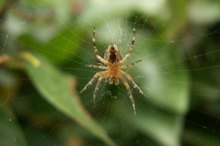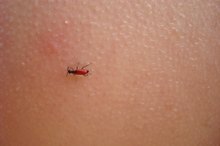Various Stages of Spider Bites
The thought of being bitten by a spider causes fear in many people. Although spider bites can range from being very mild to very severe and venomous, spiders don't usually attack unless they feel threatened. Cause for concern over a spider bite will depend on the person's possible allergic reaction, or if the spider who bites is a dangerous species such as a black widow or brown recluse 1. As with many stings or bites, the irritated skin goes through phases of injury until it heals. In cases of spider bites from spiders such as a brown recluse, this process can be very dramatic and sometimes hard to watch 1.
Initial Symptoms
Once bitten, the person may not even be aware that it took place. If anything is felt, it is normally just a stinging sensation. A blister may appear at the site of the bite with swelling around it. As time passes, the swelling increases as does the pain. In some rare cases at this stage, a bitten person may feel restless or have chills, fever, nausea, vomiting or may even go into shock. The characteristics of the bite over time will show the signature red, white and blue sign.
- Once bitten, the person may not even be aware that it took place.
- A blister may appear at the site of the bite with swelling around it.
Progression
How to Tell the Difference of a Spider or Deer Tick Bite
Learn More
As the venom of the spider bite does its damage, the site of the bite begins to develop a very painful deep wound. The venom that originally causes the irritation and swelling of the surrounding tissues also causes necrosis (or tissue death) to occur. The wound can open into a deep hole into the skin, and depending on the amount of venom that was injected, can cause a very graphic wound that varies in size.
Wound Healing
The result of a brown recluse spider bite can be psychologically traumatic by the time it does the most damage that will occur 1. The dead skin that remains on the body at the bite location will begin to slough off. This area will remain sore, and depending on the severity, will be prone to infection and other secondary concerns. Healing can take anywhere from a week up to eight weeks.
- The result of a brown recluse spider bite can be psychologically traumatic by the time it does the most damage that will occur 1.
Scarring
Poisonous Wood Spiders
Learn More
In some cases, depending on the severity of the spider bite, scarring may remain once the actual bite itself has healed. In some more severe cases where surgery was necessary, scarring may also be a result from treatment of the bite.
Related Articles
References
- Ohio Line: Brown Recluse Spider
- Cedars Sinai Medical Center. Brown Recluse and Black Widow Spider Bites in Children.
- Sotelo-cruz N, Gómez-rivera N. [Neurotoxic manifestations of black widow spider envenomation in paediatric patients]. Neurologia. 2016;31(4):215-22. doi:10.1016/j.nrl.2015.05.007
- Williams M, Nappe TM. Black Widow Spider Toxicity. StatPearls Publishing. Updated March 8, 2019.
- Stoecker WV, Vetter RS, Dyer JA. NOT RECLUSE-A Mnemonic Device to Avoid False Diagnoses of Brown Recluse Spider Bites. JAMA Dermatol. 2017;153(5):377-378. doi:10.1001/jamadermatol.2016.5665
- Vetter RS. The distribution of brown recluse spiders in the southeastern quadrant of the United States in relation to loxoscelism diagnoses. South Med J. 2009;102(5):518-22. doi:10.1097/SMJ.0b013e3181a0abb3
- Illinois Department of Public Health. Brown Recluse and Black Widow Spiders.
- Rahmani F, Banan Khojasteh SM, et al. Poisonous Spiders: Bites, Symptoms, and Treatment; an Educational Review. Emerg (Tehran). 2014;2(2):54-8.
- Gaver-wainwright MM, Zack RS, Foradori MJ, Lavine LC. Misdiagnosis of spider bites: bacterial associates, mechanical pathogen transfer, and hemolytic potential of venom from the hobo spider, Tegenaria agrestis (Araneae: Agelenidae). J Med Entomol. 2011;48(2):382-8. doi:10.1603/ME09224
- Livshits Z, Bernstein B, Sorkin LN, Smith SW, Hoffman RS. Wolf spider envenomation. Wilderness Environ Med. 2012;23(1):49-50. doi:10.1016/j.wem.2011.11.010
- Meires J, Louden B. Bite of the Brown Recluse Spider. Clinical Review. 2010(12):14-17.
- Pagac BB, Reiland RW, Bolesh DT, Swanson DL. Skin lesions in barracks: consider community-acquired methicillin-resistant Staphylococcus aureus infection instead of spider bites. Mil Med. 2006;171(9):830-2. doi:10.7205/milmed.171.9.830
- Mikals K, Beakes D, Banks TA. Stinging the Conscience: A Case of Severe Hymenoptera Anaphylaxis and the Need for Provider Awareness. Mil Med. 2016;181(10):e1400-e1403. doi:10.7205/MILMED-D-15-00536
- Gaver-Wainwright MM, Zack RS, Foradori MJ, Lavine LC. Misdiagnosis of spider bites: bacterial associates, mechanical pathogen transfer, and hemolytic potential of venom from the hobo spider, Tegenaria agrestis (Araneae: Agelenidae). J Med Entomol. 2011 Mar;48(2):382-8.
- Isbister GK, Framenau VW. Australian wolf spider bites (Lycosidae): clinical effects and influence of species on bite circumstances. J Toxicol Clin Toxicol. 2004;42(2):153-61.
- Livshits, Z., Bernstein, B., Sorkin, L., Smith, S., & Hoffman, R. (2012). Wolf Spider Envenomation. Wilderness & Environmental Medicine, 23(1), 49-50. doi:10.1016/j.wem.2011.11.010
- Pagac BB, Reiland RW, Bolesh DT, Swanson DL. Skin lesions in barracks: consider community-acquired methicillin-resistant Staphylococcus aureus infection instead of spider bites. Mil Med. 2006 Sep;171(9):830-2.
- Payne, K., Schilli, K., Meier, K., Rader, R., Dyer, J., & Mold, J. et al. (2014). Extreme Pain From Brown Recluse Spider Bites. JAMA Dermatology, 150(11), 1205. doi:10.1001/jamadermatol.2014.605
- Robinson, J., Kennedy, V., Doss, Y., Bastarache, L., Denny, J., & Warner, J. (2017). Defining the complex phenotype of severe systemic loxoscelism using a large electronic health record cohort. PLOS ONE, 12(4), e0174941. doi:10.1371/journal.pone.0174941
- Stoecker, W., Vetter, R., & Dyer, J. (2017). NOT RECLUSE—A Mnemonic Device to Avoid False Diagnoses of Brown Recluse Spider Bites. JAMA Dermatology. doi:10.1001/jamadermatol.2016.5665
Writer Bio
Based in Phoenix, Arizona, Shae Freeman has been freelancing professionally since 2005. Her writing specializes in health care and rare diseases. Freeman enjoys a loyal readership who follow her blogs and an online magazine she created called Urban ELITE. She is a professionally certified Emergency Medical Technician, currently working on her paramedic certification.








